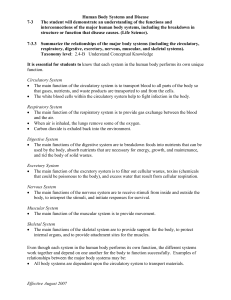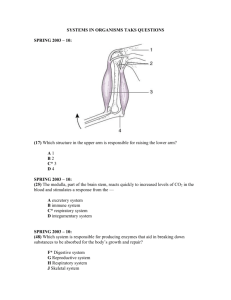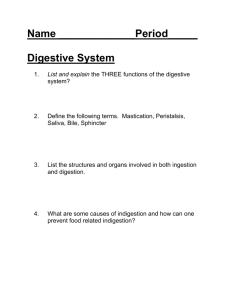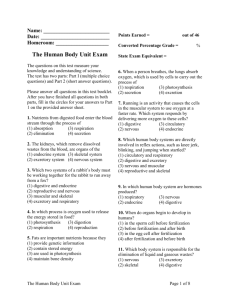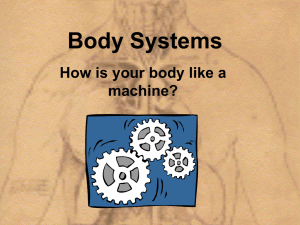Body System Interactions
advertisement
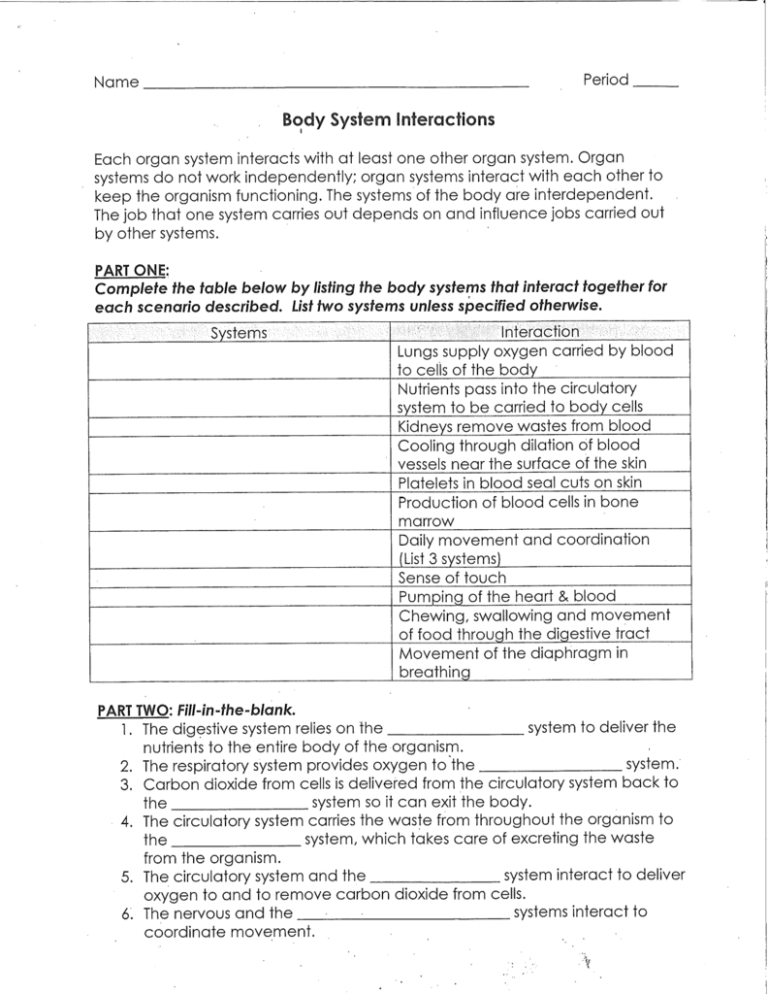
Name Period Body System Interactions I Each organ system interacts with at least one other organ system. Organ systems do not work independently; organ systems interact with each other to keep the organism functioning. The systemsof the body are interdependent. The job that one system carries out depends on and influence jobs carried out by other systems. PART ONE: Complete the table below by listing the body systems that interact together for each scenario described. List two systems unless specified otherwise. .... Systems ' •r ÿ • interaction ÿ: , Lungs supply oxygen carried by blood to cells of fhe body Nutrients pass into the circulatory system to be carried to body cells Kidneys remove wastes from blood Cooling through dilation Of blood vessels near the surface of the skin Platelets in blood seal cuts on skin Production of blood cells in bone marrow Daily movement and coordination (List 3 systems) Sense of touch Pumping of the heart & blood Chewing, swallowing and movement of food through the digestive tract Movement of the diaphragm in breathing PART TWO: Fill-in-the-blank. system to deliver the 1. The digestive system relies on the nutrients to the entire body of the organism. 2. The respiratory system provides oxygen to the system. 3. Carbon dioxide from cells is delivered from the circulatory system back to the system so it can exit the body. 4. The circulatory system carries the waste from throughout the organism to the system, which takes care of excreting the waste from the organism. 5. The circulatory system and the system interact to deliver oxygen to and to remove carbon dioxide from cells. 6L The nervous and the systems interact to coordinate movement. : 'ÿ PART THREE: Multiple Choice. 1)Your body needs to send urine out of the body. Which systems are involved? A. Endocrine and excretory systems B. Excretory and muscular systen:ÿs. C. Muscular and digestive systems D. Nervous and endocrine systems 2)What two body systems are most useful in getting nutrients from the food you eat to your brain? A. muscular and endocrine systems B. nervous and digestive systems C. nervous and circulatory systems D. circulatory and digestive systems 3)A student is outside on a very hot day. How does perspiration help maintain his body heat? A. It prevents heat from entering his body. B. It causes evaporation and carries away body heat. C. It washes off bacteria off his skin. D. It causes evaporation and saves body heat. 4)Feedback mechanisms that regulate sugar levels in the biood belong to which system? A. Nervous system B. Immune system C. Digestive system D. Endocrine system 5)The function of the cardiovascular or circulatory system is to transport blood throughout the body. What organ provides the force needed to transport or move the blood? A. Arteries B. Brain C. Heart D. Capillaries 6)The pumping of the heart is the force that directly A. moves blood through the arteries B. causes the lungs to expand C. sends nerve messages to the brain D. allows movement of the muscles 7) Which two body systems interact to send oxygen throughout the body? A. Integumentary and muscular systems B. Skeletal and reproductive systems C. Respiratory and circulatory systems D. Digestive and nervous systems 8) Which of the following is a direct interaction of the skeletal, muscular and nervous systems? A. Feeling tired after eating a meal B. Movement of a person's arm C. Healing of a cut on the arm D. Increased production of hormones 9) Which organ systems are responsible for supplying the body with energy from food molecules? A. Skeletal and circulatory systems B. Digestive and nervous systems C. Circulatory and digestive systems D. Muscular and skeletal systems 10) The immune system keeps the body stable by A. keeping the body's temperature normal B. excreting wastes C. killing disease-causing organisms D. breaking down food into useable molecules 11)Which substance, needed by the body cells, enters the body through the lungs? A. carbon dioxide B. oxygen. C. nitrogen D. hemoglobin 12)Which organ systems are responsible for regulating body temperature and blood sugar levels? A. Integumentary and endocrine systems B. Endocrine and excretory systems C. Nervous and endocrine systems D. Endocrine and circulatory systems 13.) Which two systems of a rabbit's body must be working together for the rabbit to run away from a fox? A. digestive and endocrine B. reproductive and nervous C. muscular and skeletal D. excretoryand respiratory 14.) When a person breathes, the lungs absdrb oxygen, which is used by cells to carry out the process of A. respiration C. photosynthesis B. secretion D. excretion 15.) Running is an activity that causes the cells in the muscular system to use oxygen at a faster rate. Which system responds by delivering more oxygen to these cells? A. digestive B. nervous C. circulatory D. endocrine ' 16.) Which human body systems are directly involved in reflex actions, such as knee jerk, blinking, and jumping when startled? A. circulatory and respiratory B. digestive and excretory C. nervous and muscular D. reproductive and skeletal 17.) Which three systems of the human body function together to move and control body parts? A. nervous, skelÿetal, and muscular B. muscular, endocrine, and excretory C.digestive, excretory, and reproductive D. circulatory, endocrine, and respiratory 18.) The diagram below shows a human arm bending at the elbow. Which two body systems most directly cause the arm to bend? A. skeletal and muscular B. reproductive and endocrine C. respiratory and excretory D. nervous and digestive :Human Circulatory system Human Res]3iratory System 2.) The two human body systems shown to the right interact to perform several functions for the whole organism. Describe how gas exchange occurs when the circulatory and respiratory systems work together. Jÿ Maintaining a constant body temperature, no matter what the temperature of its surroundings, is a condition that needs to be balanced in many organisms. This ability is important to the organism's survival. These organisms have many different body structures and behaviors that help maintain a constant body temperature. 3.) Whales have a thick layer of blubber (fat) under their skin. How does this blubber help the whales to maintain a constant body temperature? 4.) Humans sweat when they are in the hot sun. How does sweating help humans to maintain a constant body temperature? 5.) Foxes living in different parts of the world have different-sized ears. The arctic fox, which lives in cold climates, has small ears. The desert fox, which lives in hot climates, has large ears. How does ear size help each of these foxes to maintain a constant body temperature? 19.) The table below shows the symptoms of.some diseases that are caused by bacteria. Symptoms Disease botulism pneumonia typhoid fever tetanus vomiting, abdominal pain, coughing, muscular weakness, visual disturloance inflammation of lungs, fever, shortness of breath, fluid in lungs red rashes, high fever, intestinal bleeding uncontrolled contractions of voluntary muscles Which two diseases listed in the table affect the digestive system? A. botulism and typhoid fever B. botulism and pneumonia C. tetanus and pneumonia D. tetanus and typhoid fever 20.) Which two body systems interact in the lungs? A. the urinary system and the reproductive system B. the endocrine system and the lymphatic system C. the nervous system and the muscular system D. the circulatory system and the respiratory system 21.) Which system controls homeostasis in the human body? A. The endocrine system B. The urinary system C. The lymphatic system D. The nervous system :22.) Which of these is an example of a positive feedback mechanism? A. Blood vessels dilate to release internal body heat to control temperature. B. A woman's uterus contracts during childbirth to push the baby out of • the birth canal. C. Kidneys filter at a faster rate when salt concentration in the body gets too high. D. The heart pumps slower to respond to an increase in blood pressure. PART FOUR: Free Response. 1.) How does the skeletal system interact with 5 other human body systems?


